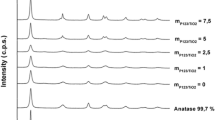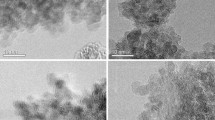Abstract
Despite of the widespread use of manufactured nanomaterials and increasing concerns on their potential risk, only limited information is available on their physicochemical properties in toxicologically relavant aqueous media. Here, P25 TiO2 (Evonik GmbH), one of the well-known and widely-used photocatalytic TiO2, was dispersed and fractionated in aqueous media, and its physicochemical properties, especially for its sub-100 nm fraction, was carefullly studied. The colloidal properties of TiO2 nanoparticles, such as ag]glomeration and sedimentation, were found strongly dependent on the physicochemical characteristics of nanoparticles (e.g., hydrodynamic size distribution, type of capping ligands and surface charge) as well as those of the aqueous media used (e.g., ionic strength and chemical compositions). This study has shown the importance of standardized dispersion and characterization protocol for toxicity tests, which is urgently needed for reliable, reproducible and impartial toxicity tests of manufactured nanomaterials.
Similar content being viewed by others
References
Nel, A., Xia, T., Madler, L. & Li, N. Toxic potential of materials at the nanolevel.Science 311, 622–627 (2006).
Carlson, C.et al.Unique cellular interaction of silver nanoparticles: size-dependent generation of reactive oxygen species.J. Phys. Chem. B 112, 13608–13619 (2008).
Hussain, S. M., Hess, K. L., Gearhart, J. M., Geiss, K. T. & Schlag]er, J. J. In vitro toxicity of nanoparticles in BRL 3A rat liver cells.Toxicol. In Vitro 19, 975–983 (2005).
OECD. Manufactured Nanomaterials: Work Programe 2009-2012, Vol. 16. (2009).
Gumy, D.et al.Catalytic activity of commercial of TiO2 powders for the abatement of the bacteria (E-coli) under solar simulated light: Influence of the isoelectric point.Appl. Catal. B-Environ.63, 76–84 (2006).
French, R. A.et al. Influence of ionic strength, pH, and cation valence on ag]gregation kinetics of titanium dioxide nanoparticles.Environ. Sci. Technol.43, 1354–1359 (2009).
Long, T. C., Saleh, N., Tilton, R. D., Lowry, G. V. & Veronesi, B. Titanium dioxide (P25) produces reactive oxygen species in immortalized brain microglia (BV2): Implications for nanoparticle neurotoxicity.Environ. Sci. Technol. 40, 4346–4352 (2006).
Tryk, D. A., Fujishima, A. & Honda, K. Recent topics in photoelectrochemistry: achievements and future prospects.Electrochim. Acta 45, 2363–2376 (2000).
Gratzel, M. Photoelectrochemical cells.Nature 414, 338–344 (2001).
Salvador, A., Pascual-Marti, M. C., Adell, J. R., Requeni, A. & March, J. G. Analytical methodologies for atomic spectrometric determination of metallic oxides in UV sunscreen creams.J. Pharm. Biomed. Anal.22, 301–306 (2000).
Kong, S. J., Kim, B. M., Lee, Y. J. & Chung, H. W. Titanium dioxide nanoparticles trigger p53-mediated damag]e response in peripheral blood lymphocytes.Environ. Mol. Mutag]en.49, 399–405 (2008).
OECD. Report of OECD Workshop on Exposure Assessment and Exposure Mitigation: Manufactured Nanomaterials, Vol. 13 (2009).
Spurr, R. A. & Myers, H. Quantitative analysis of anatase-rutile mixtures with an X-ray diffractometer.Anal. Chem.29, 760–762 (2002).
Evonic Safety data sheet AEROXIDE TiO2 P25, Vol. 3.7/REG EU (2008).
Jiang, J. K., Oberdorster, G. & Biswas, P. Characterization of size, surface charge, and ag]glomeration state of nanoparticle dispersions for toxicological studies.J. Nanopart. Res. 11, 77–89 (2009).
Morrison, I. & Ross, S. Colloidal Dispersions: Suspensions, Emulsions, and Foams. Wiley-Interscience, New York (2002).
US.EPA. Methods for Measuring the Acute Toxicity of Effluents and Receiving Waters to Freshwater and Marine Organisms. Washington, DC (2002).
Author information
Authors and Affiliations
Corresponding author
Rights and permissions
About this article
Cite this article
Kwon, D., Lee, S.H., Kim, J. et al. Dispersion, fractionation and characterization of sub-100nm P25 TiO2 nanoparticles in aqueous media. Toxicol. Environ. Health. Sci. 2, 78–85 (2010). https://doi.org/10.1007/BF03216516
Accepted:
Issue Date:
DOI: https://doi.org/10.1007/BF03216516




